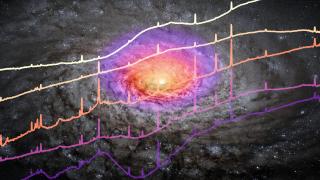Bibcode
Alonso-Tetilla, Alba V.; Shankar, Francesco; Fontanot, Fabio; Menci, Nicola; Valentini, Milena; Buchner, Johannes; Laloux, Brivael; Lapi, Andrea; Puglisi, Annagrazia; Alexander, David M.; Allevato, Viola; Andonie, Carolina; Bonoli, Silvia; Hirschmann, Michaela; López, Iván E.; Raimundo, Sandra I.; Ramos Almeida, Cristina
Referencia bibliográfica
Monthly Notices of the Royal Astronomical Society
Fecha de publicación:
2
2024
Número de citas
9
Número de citas referidas
8
Descripción
The origin of obscuration in active galactic nuclei (AGNs) is still an open debate. In particular, it is unclear what drives the relative contributions to the line-of-sight column densities from galaxy-scale and torus-linked obscuration. The latter source is expected to play a significant role in Unification Models, while the former is thought to be relevant in both Unification and Evolutionary models. In this work, we make use of a combination of cosmological semi-analytic models and semi-empirical prescriptions for the properties of galaxies and AGN, to study AGN obscuration. We consider a detailed object-by-object modelling of AGN evolution, including different AGN light curves (LCs), gas density profiles, and also AGN feedback-induced gas cavities. Irrespective of our assumptions on specific AGN LC or galaxy gas fractions, we find that, on the strict assumption of an exponential profile for the gas component, galaxy-scale obscuration alone can hardly reproduce the fraction of log (NH/cm-2) ≥ 24 sources at least at z ≲ 3. This requires an additional torus component with a thickness that decreases with luminosity to match the data. The torus should be present in all evolutionary stages of a visible AGN to be effective, although galaxy-scale gas obscuration may be sufficient to reproduce the obscured fraction with 22 < log (NH/cm-2) < 24 (Compton-thin, CTN) if we assume extremely compact gas disc components. The claimed drop of CTN fractions with increasing luminosity does not appear to be a consequence of AGN feedback, but rather of gas reservoirs becoming more compact with decreasing stellar mass.
Proyectos relacionados

Actividad Nuclear en Galaxias: una Perspectiva 3D del Núcleo y su Entorno
Nuestro proyecto puede dividirse en dos líneas principales de investigación. En primer lugar, el estudio de los vientos producidos por cuásares luminosos oscurecidos y del impacto que estos tienen en sus galaxias anfitrionas (retroalimentación del AGN). Para ello hemos obtenido observaciones en el óptico e infrarrojo cercano con el Gran Telescopio
Cristina
Ramos Almeida